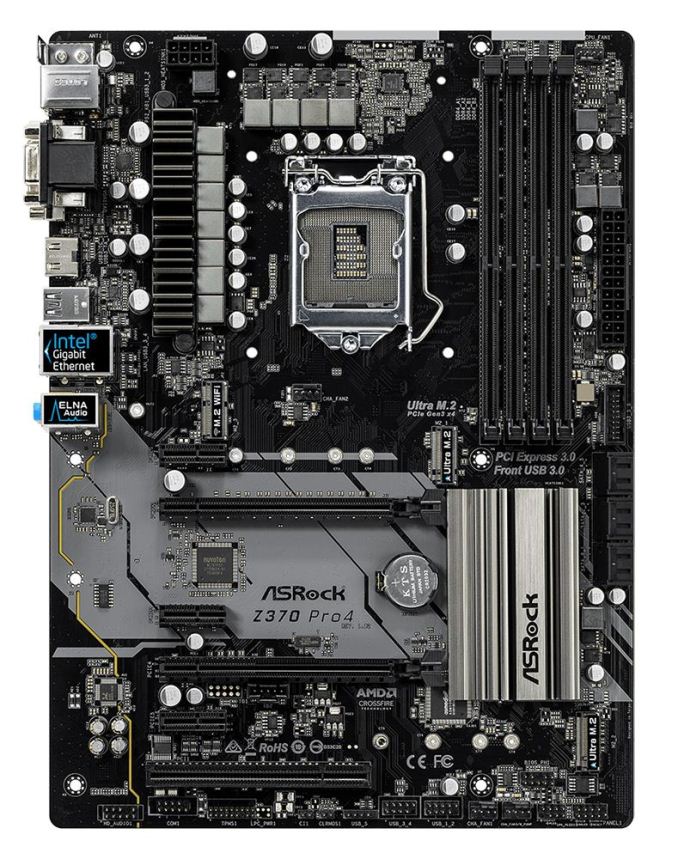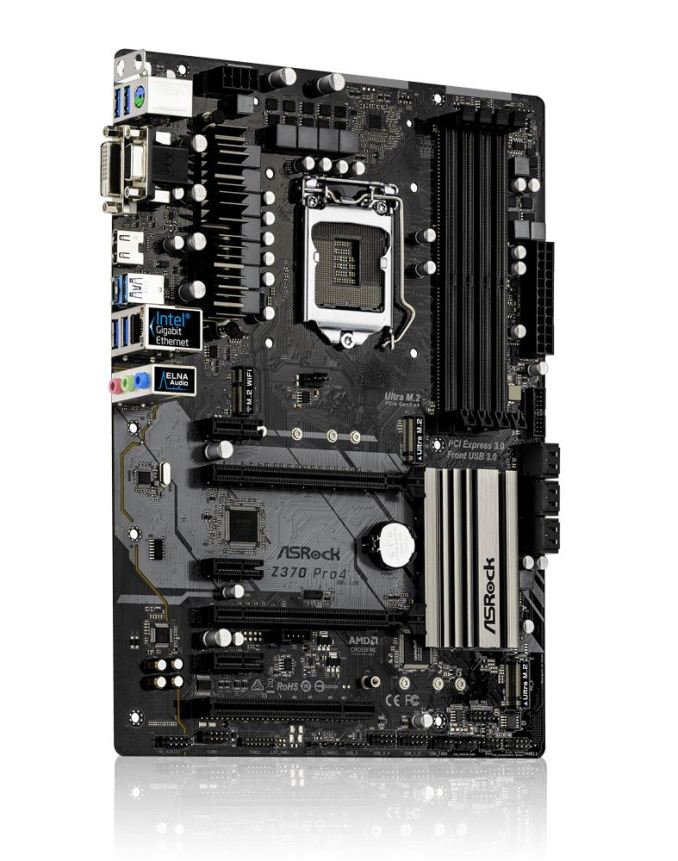Analyzing Z370 for Intel's 8th Generation Coffee Lake: A Quick Look at 50+ Motherboards
by Ian Cutress, Anton Shilov, Joe Shields & Gavin Bonshor on October 20, 2017 2:00 PM ESTASRock Z370 Pro4
The ASRock Z370 Pro4 falls on the lower end of the Z370 lineup and with that, a few of the features we’ve seen on the other boards don’t manage to make their way here. In an effort to shave a few dollars off, the Pro4 uses one VRM heatsink located on top of the left set, while the top set is left without a heatsink. In some cases, particularly when overclocking, this can lead to overheating, although this is more of an entry-level product. The board is free of any slot reinforcement, but has two M.2 slots, but only one of which is PCIe 3.0 x4 and the other supports only SATA based M.2 drives.
The Pro4’s design is predominately black, with a grey print on the PCB starting from the top of the audio section working its way by the PCIe slots through the chipset heatsink to the edge of the board. For the power delivery, the single heatsink and capacitors stick out on the board like drops of water on colored paper. The Pro4 does not look bad, but it is missing any window dressing (shrouds) and RGB LEDs. In fact, no RGB headers can be found on this board. (Ian: Perhaps that is a good thing.)
Even though this is an entry-level ‘Pro’ board, the full 64GB of memory can be used, with speeds up to DDR4-4266 listed as being supported. There are two full-length PCIe slots, but only the first is powered by the processor for x16 connectivity. The second full-length is a PCIe x4 from the chipset, and there are three other PCIe x1 slots also from the chipset. The final slot on the board is a legacy PCI slot. Overall, SLI is not supported, however Crossfire in x16/x4 mode is a possibility.
Storage options include six SATA ports and two M.2 ports. The SATA ports support RAID 0, 1, 5, and 10 and also share connectivity with the M.2 slots. If the first M.2 is occupied by a SATA type device, SATA 5 will be disabled. If the second M.2 slot has a SATA type device, SATA 0 will be disabled. Note only the top M.2 slot supports PCIe 3.0 x4 speeds, while the second M.2 slot is relegated to SATA only duties. For USB there are three USB 2.0 and one USB 3.1 (5 Gbps) headers.
Users will find four 4-pin fan headers on the board, with the Chassis Optional/Water Pump fan connector which can deliver a maximum of 1.5A/18W for water pumps that require extra power. The Realtek ALC892 audio codec is from the last generation and uses ELNA audio caps, and although this is a 7.1 channel audio codec, in order to configure 7.1 channel HD audio, the HD front panel audio is required and enabled through the driver. Networking duties are handled by the Intel I219-V gigabit Ethernet controller.
There is no USB 3.1 (10 Gbps) support here - instead, the back panel IO has five USB 3.1 (5 Gbps) Type-A ports and one Type-C port. On the rest of the back panel, users can find a PS/2 port, D-Sub/DVI-D/HDMI video outputs, and a three-jack audio stack.













83 Comments
View All Comments
tommythorn - Monday, October 23, 2017 - link
While that feature page is great, the thunderbolt part is slightly misleading as a few of them supports it via an add-in-card. The page only lists the one that has it built-in. (The lackluster support for TB3 as well as 10 GbE is disappointing).OFelix - Saturday, October 21, 2017 - link
ThanksStochastic - Friday, October 20, 2017 - link
Would you consider putting out some simple Wirecutter-style recommendations? A lot of people (including myself) would like someone else who is better informed to simplify the decision-making process.Ian Cutress - Friday, October 20, 2017 - link
When we get our Z370 reviews underway, we'll start doing some buyers guidesStochastic - Friday, October 20, 2017 - link
Great, thanks!IGTrading - Sunday, October 22, 2017 - link
When do we get a 50+ AMD motherboard article guys ? :)abrowne1993 - Friday, October 20, 2017 - link
Okay but which one looks the coolest?dave_the_nerd - Friday, October 20, 2017 - link
"Whoever thought this was a good idea at Intel needs to be fired."Well... gee... why don't you tell us how you really feel?
DigitalFreak - Friday, October 20, 2017 - link
This whole notch thing makes me wonder if the 8xxx series was originally supposed to work in existing motherboards, but Intel ran into issues at the last minute.KaarlisK - Saturday, October 21, 2017 - link
Honestly, I cannot see the issue. The pins were changed so that nothing bad will happen if you put the wrong CPU in the wrong motherboard.As for the notches, I for one am happy that they were not changed. This means they can reuse the physical design, which lowers validation costs, which makes the CPUs cheaper.